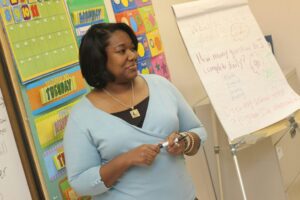Introduction
Curriculum and Instruction are two interrelated and essential aspects of education that guide and shape the teaching and learning process in k-12 schools. Curriculum refers to the planned and organized set of goals, objectives, standards, content, and activities that define what students are expected to learn and achieve in each subject and grade level. Instruction refers to the methods, strategies, and practices that teachers use to deliver, facilitate, and assess the curriculum, and to support the diverse needs, interests, and abilities of each student.
However, Curriculum and Instruction also involve many challenges and opportunities for k-12 schools. Schools may have to align their curriculum and instruction with the national, state, or local standards and expectations, and with the best practices and research in the field of education. Schools may also have to adapt their curriculum and instruction to the changing demands and realities of the 21st century society and workforce, and to the emerging trends and innovations in technology and pedagogy. Schools may also have to balance the academic, social, and emotional development of their students, and to foster a culture of excellence, equity, and diversity.
To help schools understand and address these Curriculum and Instruction issues, here are some common terms and definitions that are used in the field of Curriculum and Instruction.
List of Common Curriculum & Instruction Terms and Definitions
- Alignment: The degree of consistency and coherence between the curriculum, instruction, and assessment, and the standards and expectations for student learning and achievement, at the national, state, or local level.
- Assessment: The process of gathering and analyzing evidence of student learning and achievement, using various tools and methods, such as tests, quizzes, portfolios, rubrics, or observations, to measure the extent to which students have met the curriculum goals and objectives, and to provide feedback, guidance, and support for improvement.
- Backward Design: A curriculum design approach that starts with identifying the desired learning outcomes and evidence of learning, and then works backward to plan the learning activities and content that will lead to those outcomes, ensuring alignment and coherence between the curriculum and the assessment.
- Bloom’s Taxonomy: A framework for classifying and organizing the levels of cognitive skills and processes that are involved in learning, from lower-order to higher-order, such as remembering, understanding, applying, analyzing, evaluating, and creating.
- Cooperative Learning: A teaching strategy that involves grouping students in small teams or groups, where they work together to complete a task, solve a problem, or learn a concept, and where they share responsibility, accountability, and interdependence, and benefit from each other’s skills, knowledge, and feedback.
- Curriculum Framework: A document or a guide that outlines the scope, sequence, and structure of the curriculum, and that provides the rationale, goals, objectives, standards, content, and assessment for each subject and grade level, based on the state or national expectations and guidelines for student learning and achievement.
- Curriculum Mapping: A process of creating and reviewing a visual representation or a document that shows the scope and sequence of the curriculum, such as the topics, skills, assessments, and resources, that are covered in each subject and grade level, throughout the school year, and how they are aligned with the standards and objectives.
- Differentiated Instruction: A teaching approach that recognizes and responds to the diverse needs, interests, and abilities of each student, by providing multiple options and pathways for learning, such as content, process, product, or environment, and by adjusting the pace, level, and complexity of instruction, to maximize student growth and success.
- Direct Instruction: A teacher-centered and explicit approach to instruction that involves presenting the content and skills in a clear and structured way, using modeling, examples, and practice, and providing immediate and corrective feedback, to ensure student mastery and retention.
- Formative Assessment: A type of assessment that occurs during the learning process, rather than at the end, and that provides ongoing and timely feedback to students and teachers, to monitor and improve student learning and instruction, and to identify the strengths and weaknesses of students, and the areas for improvement or intervention.
- Inquiry-Based Learning: A student-centered and active learning approach that involves engaging students in exploring, investigating, or researching a question, problem, or phenomenon, that sparks their curiosity and interest, and that requires them to use their prior knowledge, skills, and resources, to construct new knowledge and understanding, and to communicate their findings and conclusions.
- Integrated Curriculum: A curriculum design approach that connects and integrates the content and skills from different subject areas, such as math, science, language arts, or social studies, around a common theme, topic, or project, that is relevant and meaningful for students, and that allows them to apply their learning across the disciplines, and to make connections to the real world.
- Instructional Scaffolding: A technique that involves providing temporary and appropriate support and guidance to students, to help them perform a task or learn a skill that is beyond their current ability or level, and gradually removing or fading the support, as students become more independent and confident, and achieve mastery.
- Learning Objective: A specific and measurable statement that describes what students are expected to know, understand, or be able to do, as a result of a lesson, unit, or course, and that guides the planning, delivery, and assessment of instruction.
- Learning Standard: A general and broad statement that defines the level of knowledge, understanding, or skill that students are expected to demonstrate, in a specific subject area and grade level, and that reflects the national, state, or local expectations and benchmarks for student learning and achievement.
- Learning Style: The preferred or dominant way that a student learns and processes information, such as visual, auditory, kinesthetic, or verbal, that may affect their performance and preferences in different learning situations and activities.
- Metacognition: The awareness and understanding of one’s own thinking and learning processes, and the ability to monitor, regulate, and evaluate one’s own cognitive strategies and actions, to improve one’s learning and performance, and to achieve one’s learning goals.
- Performance Assessment: A type of assessment that requires students to demonstrate their knowledge, understanding, or skills, by performing a complex and authentic task, such as creating a product, conducting an experiment, or presenting a solution, rather than by answering multiple-choice or short-answer questions, and that uses rubrics or criteria to evaluate the quality and effectiveness of the student’s performance.
- Personalized Learning: A student-centered and customized approach to learning that uses technology and data to tailor the curriculum, instruction, and assessment, to the individual needs, abilities, interests, and goals of each student, and that empowers students to have more voice and choice in their learning, and to progress at their own pace.
- Professional Learning Community (PLC): A group or a network of teachers, administrators, or other educators, who collaborate and communicate regularly, to share their expertise, experiences, and resources, to improve their professional practice, and to enhance student learning and achievement, based on data and evidence.
- Project-Based Learning (PBL): A student-centered and inquiry-based approach to learning that involves engaging students in authentic and meaningful projects, that are driven by their interests, questions, or problems, and that require them to apply their knowledge and skills, to create a product, solution, or presentation, that demonstrates their learning and understanding.
- Rubric: A tool or a guide that describes the criteria and levels of performance or quality for a specific task, skill, or product, such as a project, an essay, or a presentation, and that is used to guide, evaluate, and provide feedback to students and teachers, on the student’s performance or product.
- Scope and Sequence: The scope and sequence of a curriculum refers to the breadth and depth of the content and skills that are covered in each subject and grade level, and the order and progression in which they are taught and learned, throughout the school year or the course.
- Spiral Curriculum: A curriculum design approach that introduces and revisits the core concepts and skills of a subject or a discipline, at increasing levels of complexity and depth, across the grade levels, to reinforce and extend student learning and understanding.
- Standards-Based Education: An education system that is based on clearly defined and rigorous standards and expectations for student learning and achievement, in each subject and grade level, and that aligns the curriculum, instruction, and assessment, with those standards and expectations, to ensure that all students have the opportunity and support to meet or exceed them.
- Student-Centered Learning>: A learning approach that focuses on the needs, interests, and abilities of the students, rather than on the teacher, the curriculum, or the standards, and that gives students more autonomy, agency, and ownership of their learning, and more opportunities for active and collaborative learning, and for self-reflection and self-assessment.
- Summative Assessment>: A type of assessment that occurs at the end of a learning period, such as a unit, semester, or year, and that provides a summary and evaluation of student learning and achievement, using various tools and methods, such as exams, essays, projects, or presentations, to determine the extent to which students have met the curriculum goals and objectives, and to assign grades, scores, or ratings.
- Understanding by Design (UbD): A curriculum design framework that is based on the backward design approach, and that consists of three stages: (1) identifying the desired results or learning outcomes, (2) determining the acceptable evidence or assessment of learning, and (3) planning the learning experiences and instruction, that will enable students to achieve deep and enduring understanding of the essential ideas and concepts of the curriculum.
- Universal Design for Learning (UDL): A framework for designing and delivering curriculum and instruction that is accessible and inclusive for all students, regardless of their abilities, backgrounds, or learning preferences, by providing multiple means of representation, expression, and engagement, to address the variability and diversity of student learning.
- Zone of Proximal Development (ZPD): A concept developed by psychologist Lev Vygotsky, that refers to the range of tasks or skills that a student can perform or learn, with the guidance or assistance of a teacher or a peer, but not independently, and that represents the potential or optimal level of learning and development for that student.
Conclusion
Curriculum and Instruction are two key and interrelated components of education that influence and shape the teaching and learning process in k-12 schools. Curriculum and Instruction involve various terms and definitions that are used to describe and explain the goals, content, methods, and outcomes of education, and that reflect the challenges and opportunities that schools face in providing quality and relevant education for their students. By learning and understanding the basic terms and definitions of Curriculum and Instruction, schools can better prepare and equip themselves with the necessary knowledge and skills to design and deliver effective and engaging curriculum and instruction, and to support their students in their learning journey.







